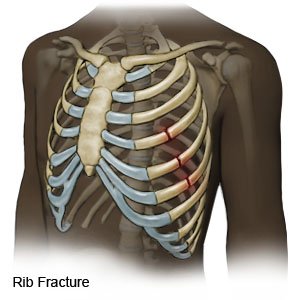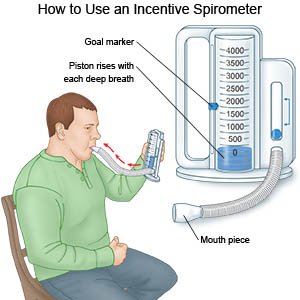Rib Fracture in Children
Medically reviewed by Drugs.com. Last updated on Apr 6, 2025.
AMBULATORY CARE:
A rib fracture
is a crack or break in one or more of your child's ribs. Greater force is needed to break the bones of children younger than 7 years old than the bones of older children and adults. The greater force increases the risk of damage to the heart, lungs, diaphragm, liver, spleen, or other organs.
 |
Common signs and symptoms:
- Your child has chest pain when he or she breathes, coughs, or moves.
- You may see your child hold the injured side while breathing.
- You may see bruises around the area of the rib fracture.
Call your local emergency number (911 in the US) for any of the following:
- Your child has trouble breathing.
- Your child has new or increased pain.
Seek care immediately if:
- Your child's pain does not get better, even after treatment.
- Your child has a fever.
- Your child has a cough.
Call your child's doctor if:
- You have questions or concerns about your child's condition or care.
Treatment for a rib fracture
may include medicines for pain and swelling. Ask your child's healthcare provider how to give these medicines safely. Do not splint your child's ribs. Your child will not be able to take deep breaths if his or her ribs are splinted. This will increase your child's risk of a lung infection. Rib fractures usually heal within 2 months.
Limit your child's activity:
Your child should rest as much as possible and get plenty of sleep. This will help prevent other injuries while your child's rib heals.
Ice:
Apply ice on the fractured area for 15 to 20 minutes every hour or as directed. Use an ice pack, or put crushed ice in a plastic bag. Cover it with a towel. Ice decreases swelling and pain.
Deep breathing and coughing:
This exercise will decrease your child's risk for a lung infection. Have your child hug a pillow on the injured side while doing this exercise, to decrease pain. Ask your child to take a deep breath and hold it for as long as possible. Your child should let the air out and then cough strongly. Deep breaths help open your child's airway. Your child may be given an incentive spirometer to help take deep breaths. Put the plastic piece in your child's mouth. Have your child take a slow, deep breath. Your child should then let the air out and cough. Repeat these steps 10 times every hour.
 |
Follow up with your child's doctor as directed:
Write down your questions so you remember to ask them during your visits.
© Copyright Merative 2025 Information is for End User's use only and may not be sold, redistributed or otherwise used for commercial purposes.
The above information is an educational aid only. It is not intended as medical advice for individual conditions or treatments. Talk to your doctor, nurse or pharmacist before following any medical regimen to see if it is safe and effective for you.
Further information
Always consult your healthcare provider to ensure the information displayed on this page applies to your personal circumstances.
